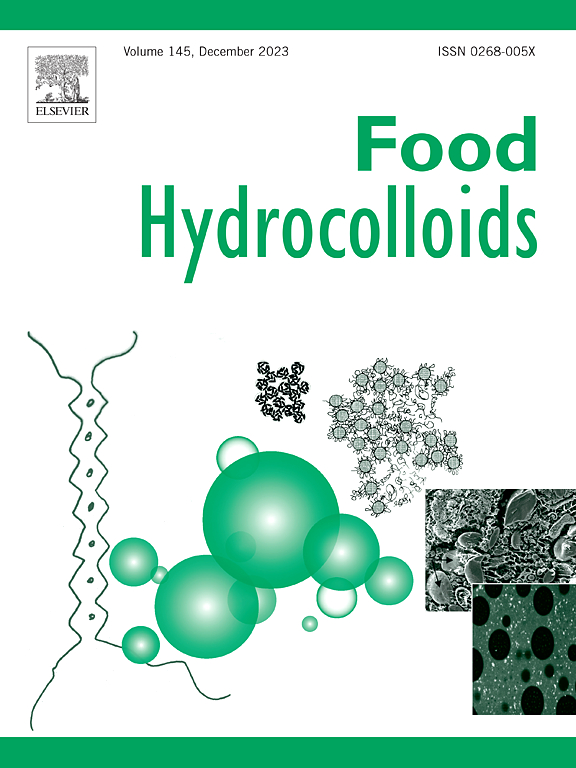Eco-friendly food packaging films: Sustainable alginate extraction from Sargassum via enzymatic engineering
IF 11
1区 农林科学
Q1 CHEMISTRY, APPLIED
引用次数: 0
Abstract
Alginate, a natural polysaccharide, has demonstrated significant potential in food packaging due to its biodegradability and functionality. This study utilized Sargassum (a non-edible brown seaweed) as the raw material and employed a combined enzymatic method to extract alginate, achieving a final alginate yield of 41.38 ± 0.44 %. The extracted alginate was characterized by fourier transform infrared (FT-IR), gel permeation chromatography (GPC), and nuclear magnetic resonance (NMR), confirming its excellent film-forming properties. Composite films were developed by blending alginate with hydroxypropyl methylcellulose (HPMC), titanium dioxide (TiO2), and ε-polylysine (ε-PL). Furthermotre, the structural and functional properties of the films were analyzed. Compared to pure alginate films, the composite films exhibited improved mechanical strength, thermal stability, barrier properties, and antimicrobial activity. Notably, HPMC improved mechanical flexibility, TiO2 conferred UV-resistant durability, while ε-PL exhibited membrane-disruptive antimicrobial action, synergistically enhancing multifunctionality. Additionally, compared to commercial polyethylene film, the composite films applied to Physalis peruviana L. reduced weight loss by 19.60 % and better preserved their soluble solids (13.07 ± 0.31 %), titratable acidity (10.38 ± 0.36 g/kg), vitamin C (17.46 ± 0.86 mg/100 g), total phenolics (8.41 ± 0.42 mg/g), and flavonoids (1.52 ± 0.03 mg/g). The composite films also effectively enhanced the antioxidant defense system in P. peruviana. This study establishes a mechanistically informed strategy for sustainable alginate extraction and its translation into biodegradable, high-barrier food packaging materials.

环保食品包装薄膜:通过酶工程从马尾藻中可持续提取海藻酸盐
海藻酸盐是一种天然多糖,由于其生物降解性和功能性,在食品包装中显示出巨大的潜力。本研究以马尾藻(一种不可食用的褐藻)为原料,采用联合酶法提取藻酸盐,最终的藻酸盐得率为41.38±0.44%。通过傅里叶变换红外(FT-IR)、凝胶渗透色谱(GPC)和核磁共振(NMR)对提取的海藻酸盐进行了表征,证实了其良好的成膜性能。采用海藻酸盐与羟丙基甲基纤维素(HPMC)、二氧化钛(TiO2)和ε-聚赖氨酸(ε-PL)共混制备复合膜。并对膜的结构和功能特性进行了分析。与纯海藻酸盐膜相比,复合膜具有更好的机械强度、热稳定性、屏障性能和抗菌活性。值得注意的是,HPMC提高了机械柔韧性,TiO2提高了抗紫外线耐久性,而ε-PL具有膜破坏抗菌作用,协同增强了多功能。此外,与市产聚乙烯膜相比,该复合膜对青花Physalis peruviana L.减轻了19.60%的失重,更好地保存了可溶性固形物(13.07±0.31%)、可滴定酸度(10.38±0.36 g/kg)、维生素C(17.46±0.86 mg/100 g)、总酚(8.41±0.42 mg/g)和总黄酮(1.52±0.03 mg/g)。复合膜还能有效增强紫花海棠的抗氧化防御系统。本研究建立了可持续海藻酸盐提取及其转化为可生物降解的高屏障食品包装材料的机械知情策略。
本文章由计算机程序翻译,如有差异,请以英文原文为准。
求助全文
约1分钟内获得全文
求助全文
来源期刊

Food Hydrocolloids
工程技术-食品科技
CiteScore
19.90
自引率
14.00%
发文量
871
审稿时长
37 days
期刊介绍:
Food Hydrocolloids publishes original and innovative research focused on the characterization, functional properties, and applications of hydrocolloid materials used in food products. These hydrocolloids, defined as polysaccharides and proteins of commercial importance, are added to control aspects such as texture, stability, rheology, and sensory properties. The research's primary emphasis should be on the hydrocolloids themselves, with thorough descriptions of their source, nature, and physicochemical characteristics. Manuscripts are expected to clearly outline specific aims and objectives, include a fundamental discussion of research findings at the molecular level, and address the significance of the results. Studies on hydrocolloids in complex formulations should concentrate on their overall properties and mechanisms of action, while simple formulation development studies may not be considered for publication.
The main areas of interest are:
-Chemical and physicochemical characterisation
Thermal properties including glass transitions and conformational changes-
Rheological properties including viscosity, viscoelastic properties and gelation behaviour-
The influence on organoleptic properties-
Interfacial properties including stabilisation of dispersions, emulsions and foams-
Film forming properties with application to edible films and active packaging-
Encapsulation and controlled release of active compounds-
The influence on health including their role as dietary fibre-
Manipulation of hydrocolloid structure and functionality through chemical, biochemical and physical processes-
New hydrocolloids and hydrocolloid sources of commercial potential.
The Journal also publishes Review articles that provide an overview of the latest developments in topics of specific interest to researchers in this field of activity.
 求助内容:
求助内容: 应助结果提醒方式:
应助结果提醒方式:


